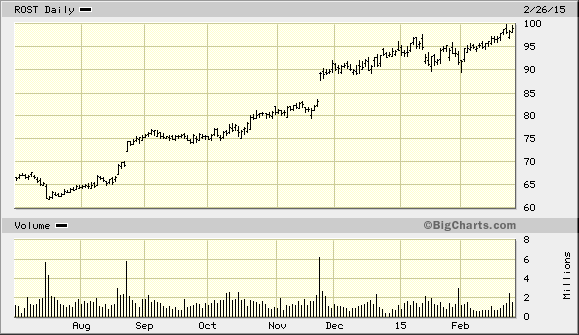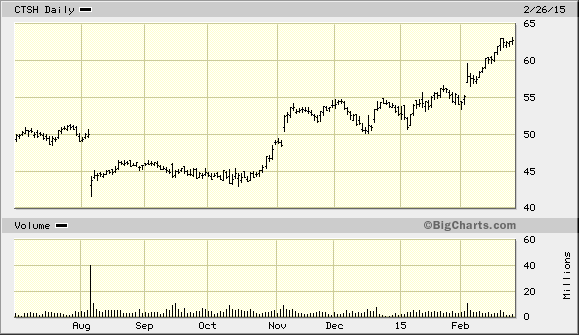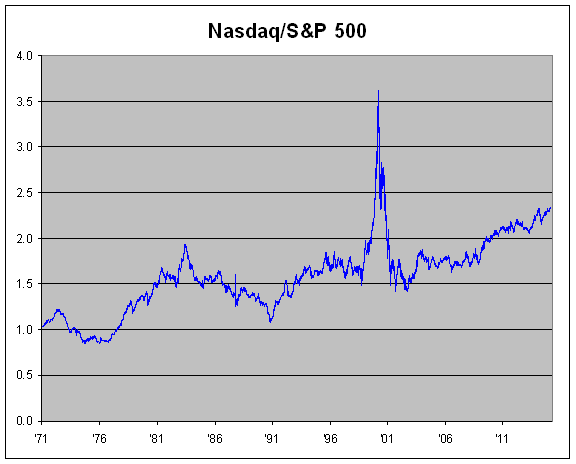Archive for February, 2015
-
Warren Buffett’s Shareholder Letter
Eddy Elfenbein, February 28th, 2015 at 9:14 amHere’s the latest shareholder letter from Warren Buffett.
-
Q4 GDP Revised Down to +2.2%
Eddy Elfenbein, February 27th, 2015 at 9:30 am -
CWS Market Review – February 27, 2015
Eddy Elfenbein, February 27th, 2015 at 7:08 am“A person who has not made peace with his losses is likely to accept gambles
that would be unacceptable to him otherwise.” – Daniel KahnemanThe author and investor James O’Shaughnessy tells the story of a study done by Fidelity Investments. The company wanted to find out what group of its clients did the best. As it turns out, the most successful group of Fidelity investors wasn’t men or women. It wasn’t young or old. It wasn’t big portfolios or small investors. No. It was people who had forgotten they had Fidelity accounts.
That’s even lazier than buy-and-hold! It’s buy-and-forget-you-ever-bought. I can’t say I’m surprised. The reason is simple. To be a good investor, you have to counter many of your natural inclinations like getting rattled in a bear market or finding comfort in following the crowd. I’m sure the people who watched their accounts every day were far more inclined to buy and sell at the wrong times, while the blissfully ignorant stayed wisely quiet.
We’re coming up on the sixth anniversary of this bull market, and it’s interesting to see how wrong people have been. Consider this headline from the day the bear market ended:
There may have been a case for Dow 5,000, but it was fantastically wrong. The Dow closed that day at 6,547.05. A year later, the Dow had climbed more than 4,000 points to reach 10,564.38. Was that enough to silence the doubters? Not at all. Check out this headline from the Wall Street Journal exactly one year later:
I’m sure people were worried, but as they say, the market climbs a wall of worry. The bull market wasn’t even close to its peak in 2010. On Wednesday of this week, the Dow closed at an all-time high of 18,224.57. That’s more than 72% higher than when people were “worried.” As well as the Dow has done, the S&P 500 has done even better, and our Buy List has done better than both. But I envy those folks at Fidelity. They don’t know what they don’t know they’re missing.
Ross Stores Creams Earnings and Raises Dividend
I was reminded of the Fidelity study when Ross Stores (ROST) released a blow-out earnings report on Thursday. For their fiscal Q4, Ross earned $1.20 per share, which beat estimates by nine cents per share. Previously, the company had given us guidance of $1.05 to $1.09 per share, so they’re crushing their own forecasts. Going into this earnings report, I was actually a bit worried that Ross had gotten ahead of itself. No need to worry. In the after-hours session, the shares jumped more than 4% to $103 per share. What surprises me most isn’t that optimistic reaction to Ross now, but how down everyone was on Ross last summer.
In May, Ross projected fiscal-year earnings between $4.09 and $4.21 per share. I kept saying I liked the stock (here’s one example), but it kept falling. By July, the stock dropped below $62 per share. That was cheap even if Ross’s guidance was accurate, and I knew they were low-balling us. Now here we are seven months later. The fiscal year is over, and Ross made $4.42 per share. The stock is up to $103 per share. And that’s not all. Ross just increased their quarterly dividend by 18% to 23.5 cents per share.
Last week, I asked for some feedback on the newsletter. The responses I got were great. A number of you wanted to see more details on why I decide to like a particular stock. So this week, let’s dig a little bit into the numbers at Ross, and I’ll show you why this is such a strong company. For the quarter, net sales rose by 11%. With retailers, the key metric to watch is same-store sales. For Q4, Ross’s same-store sales rose by 6%. That’s a very strong number, and it’s doubtful they’ll be able to maintain that pace. Lower gas prices probably helped. For the entire year, same-store sales were up 3%.
CEO Barbara Rentler said, “We are pleased with our fourth-quarter sales and earnings, both of which were well ahead of our expectations, as our value offering on a wide assortment of name-brand bargains and gifts resonated well with our customers. Our 2014 fourth-quarter operating margin grew 45 basis points to 13.1%, benefiting from slightly higher merchandise gross margin and leverage on expenses from our robust comparable-sales gain.”
She added, “For the 2014 fiscal year, our earnings per share rose a solid 14% on top of strong multi-year increases. In addition, our fiscal 2014 operating margin increased 35 basis points to 13.5%.”
For newer investors, it’s always good to see an increase in a company’s operating margin. That means that the company is being more efficient in running its business. It also suggests that the company is holding a stronger position in their market. You have to understand that margins are very tight in retail. It’s all about cost control and managing your inventory. Last year, Walmart’s (WMT) net profit margin was just 3.3%. Most people don’t realize how small it is. With economics like that, you have to watch every penny, and things can get even tighter at the at the deep-discount end where Ross lives. Their customers are very price conscious. They’re looking for a deal, and if they don’t find it at Ross, they’ll go somewhere else. It’s just that simple.
Last year, Ross’s net profit margin was 8.4%. That’s up from 8.2% in 2013. That may sound small, but it was enough to turn a 7.9% increase in sales into a 10.4% increase in net earnings. On top of that, the number of shares declined by 3.1%, so earnings-per-share rose by 13.9%. These are the factors that separate the outstanding companies from the also-rans.
Ross also said their board has approved a program to buy back $1.4 billion worth of stock over the next two years. At the current price, that’s about 7% of the outstanding shares. I’m not a big fan of share buybacks; I’d much rather have the cash as a dividend, but this shows you how profitable Ross is. This is a 27% increase over the previous repurchase program. I also like that Ross actually reduces share count where many other companies use share buybacks to mask their executive compensation.
For the new fiscal year, which ends in January 2016, Ross sees same-store sales rising by 1% to 2%. That’s a modest forecast, but it’s safe to be conservative. Ross sees full-year EPS ranging between $4.60 and $4.80. That’s up from $4.42 per share last year. For Q1, which ends on May 2, Ross sees same-store sales rising by 2% to 3% and earnings-per-share coming in between $1.21 and $1.26. That’s up from $1.15 for last year’s Q1. This week, I’m raising my Buy Below on Ross Stores by $11 to $107 per share.
Express Scripts Is a Buy up to $89 per Share
On Monday, Express Scripts (ESRX) reported Q4 earnings of $1.39 per share. That was one penny more than estimates. The pharmacy-benefits manager had given guidance of $1.36 to $1.40 per share. For the year, ESRX earned $4.88 per share. That wraps up another solid year for them.
For the year, they had net cash flow of $4.5 billion. Investors tend to fixate on earnings. While that’s important, you should also pay attention to a company’s operating cash flow. That’s the lifeblood of any enterprise.
CEO George Paz said, “We believe our growth- and focused-acquisition approach has positioned us uniquely in the healthcare services landscape to improve health outcomes and lower cost in an aligned model that keeps our clients and patients first, but also returns exceptional results to our shareholders.”
What’s always impressed me about Express Scripts is how they’ve been able to consistently grow their earnings. Since 2008, their EPS have been $1.55, $1.79, $2.50, $2.97, $3.74, and $4.33 to $4.88. As an investor, that’s exactly what I like to see: consistent increases. This is another reason why I like consumer staples stocks and healthcare stocks. Even the best cyclical stocks will see some ups and downs to their earnings trend. After all, that’s why they’re called cyclicals.
In last week’s issue, I told you I was expecting Express Scripts to give 2015 earnings guidance of $5.35 per share, give or take. They were a little more optimistic. For 2015, ESRX said they expect earnings to range between $5.35 and $5.49 per share. That’s a 10% to 13% increase over last year’s earnings.
On Tuesday, the shares gapped up to $88.83, which is a new all-time high. But the shares pulled back later this week to close at $84.54 on Thursday. That means the shares are going for less than 16 times forward earnings. That’s a good deal. This week, I’m bumping up my Buy Below on Express Scripts to $89 per share.
The Market Wants Patience and They Want It Right Now
The earnings outlook has gotten much more subdued this year. The Q4 earnings season is just about over; 90% of the earnings reports are in. The S&P 500 grew its earnings by 4.3% last quarter. This quarter, however, analysts expect earnings to fall by 4.5%. A major reason for the earnings dip is the strong dollar, and we’ve seen that reflected in several of our earnings reports. Wall Street now expects 2015 earnings of $118.32 for the S&P 500. That’s less than a 5% increase over 2014’s earnings. Only five months ago, Wall Street was expecting 2015 earnings of $136.07.
This week, Janet Yellen testified on Capitol Hill about the Federal Reserve’s outlook for monetary policy. The Fed had already sent a reassuring message to investors, saying that the Fed will be “patient” in moving to raise interest rates. I think that helped spark the latest rally, as the S&P 500 just made another all-time high. The Nasdaq Composite rallied for 10-straight days, and it’s closing in on its all-time high from 15 years ago.
Yellen reaffirmed the Fed’s policy this week. In short, the markets want patience, and they want it right now. In my eyes, it’s hard for anyone to be worried about the Fed’s sparking inflation. Prices are falling. The latest CPI report showed that prices fell 0.7% in January. In the last three months, the seasonally-adjusted CPI is down 1.3%.
Sure, a lot of that is energy, but the “core rate,” which excludes food and energy prices, rose by just 0.2% last month. As low as that was, it was higher than expectations of a 0.1% increase.
Despite the Fed’s rhetoric, I don’t see them raising rates soon. Even if they do raise rates, they’ll need to do it several times before it has an impact on the investing climate. The current low-rate climate is a boon for investors.
The Turnaround at Cognizant
Before I go, I want to raise my Buy Below for Cognizant Technology Solutions (CTSH). The story here is very similar to what we’ve seen at Ross Stores. A few months ago, Wall Street hated Cognizant. The shares got nailed for a 12.6% loss on August 6.
What was their crime? It wasn’t earnings. Those were actually quite good. Nor was it their earnings guidance. Instead, Wall Street didn’t like Cognizant’s sales guidance. Some people you just can’t reach. In the CWS Market Review from August 8, I stuck by CTSH and told folks not to panic. In the seven months since the plunge, CTSH is up 44%. In fact, it’s up more than 25% since the day before the plunge.
Cognizant is now our top performer this year. This week, I’m raising my Buy Below to $66 per share.
That’s all for now. Next week is the first trading week of March, and we’ll get those important turn-of-the-month econ reports. ISM and personal income come out on Monday. Tuesday is auto sales. Look for good numbers from Ford. Wednesday is the Fed’s Beige Book and the ADP jobs reports. Thursday is factory orders, and that leads us up to the big day, which is Jobs Day on Friday. The government will report on the labor market on Friday morning. Be sure to keep checking the blog for daily updates. I’ll have more market analysis for you in the next issue of CWS Market Review!
– Eddy
-
Morning News: February 27, 2015
Eddy Elfenbein, February 27th, 2015 at 7:03 amGermany Supports Extension of Greek Bailout Programme
Setbacks for Tsipras Stir Discord in Greek Ruling Party
Figures Show Continued Unevenness in Japan’s Recovery
India Growth to Top 8% in 2015/2016, Says Government
Saudis’ Oil Price War Is Paying Off
U.S.’s New Fraud Chief Will Enforce Laws He Was Paid to Blunt
Republicans Pledge to Fight FCC’s Open-Web Rules
Lloyds Banking Group Returns to Profit and Resumes Dividend Payments
Barnes & Noble to Keep Nook Digital Business After All
Airbus to Increase Short-Haul Aircraft Production
IBM Pumps $4 Billion Into Cloud, Mobile Initiatives
SeaWorld Attendance Falls 4%; PETA Attributes Drop to ‘Blackfish’
Credit Writedowns: When Do We Decide That Europe Must Restructure Much of Its Debt?
Be sure to follow me on Twitter.
-
RIP: Irving Kahn
Eddy Elfenbein, February 26th, 2015 at 5:03 pmIrving Kahn has died at the age of 109. He was a student of Benjamin Graham and later, chairman emeritus of Kahn Brothers Group Inc. He started working on Wall Street in 1928.
The crash of 1929, Mr. Kahn told an interviewer in 2012, taught him that “the gambling nature of Wall Street has little or no interest in the serious, underlying nature of businesses.” He described rapid trading, then and now, as “crazy competition that had no connection to the real facts.”
His central goal as an investor, he said, was always “to know much more about the stock I’m buying than the man who’s selling does.”
For Mr. Kahn, the most important quality an investor could possess was patience. “You gain much more by slow investing and concentrating on what you know,” he said in 2012, “than on fast investing, which is nothing more than gambling.”
In an article in the Financial Analysts Journal in 1977, Mr. Kahn set out seven “guidelines for intelligent investing.” Among them: “Don’t depend on recent or current figures to forecast future prices….Capital is always at risk unless you buy better than average values….Don’t trust quarterly earnings….Look beyond the one or two largest companies in a given industry.”
He concluded, “The analyst must both practice, and to his client preach, patience.”
Kahn’s sister also lived to 109. His brother died at 101 and another sister lived to 103.
Asked on Thursday if he had any thoughts on Mr. Kahn, Warren Buffett —who also studied under Mr. Graham—joked, “I’d rather have Irving’s thoughts on longevity.”
-
Q4 Earnings Calendar
Eddy Elfenbein, February 26th, 2015 at 4:13 pmHere’s the list of our stocks and their reports for this earnings cycle.



 Eddy Elfenbein is a Washington, DC-based speaker, portfolio manager and editor of the blog Crossing Wall Street. His
Eddy Elfenbein is a Washington, DC-based speaker, portfolio manager and editor of the blog Crossing Wall Street. His